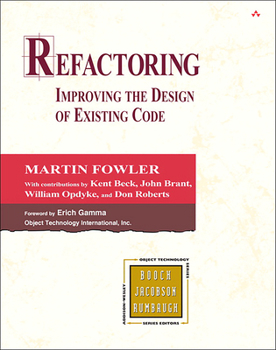Refactoring: Improving the Design of Existing Code
(Part of the Addison-Wesley Object Technology Series Series)
Select Format
Select Condition 
Book Overview
Customer Reviews
Rated 5 starsDon't wait as long as I did
I've known about this book for over a year. Initially, I thought it was about re-engineering legacy systems. I don't do that, so I didn't give it much thought. Over the past year, I have stumbled across repeated references to this book. Everyone seems to cite it, and now I understand why. It's very easy to fall into 'analysis paralysis' when doing object design. A commonly heard complaint is "I have created 27 different class...
1Report
Rated 5 starsRefactoring: Improving the Design of Existing Code
A little while back I was introduced to a word I had never heard before, Refactoring. I was told to get Martin Fowler's book and read it so I could gain a better understanding of what Refactoring was. Well folks, I would classify this book as a 'Hidden Treasure'. Although it is not a flashy or well known title, I believe its impact can be much deeper and long lasting than many of the mainstream, more popular technology books...
1Report
Rated 5 starsDon't just read it - buy it
One can read good books on a specific technology (COM, UML etc) or on specific programming languages or even on different approaches to software development (RUP, OPEN etc) but every now and then a true classic comes along. Like Design Patterns 4 years ago now refactoring comes along. Every serious OO developer should own both of these books. Get your hands on Refactoring if only to read chapter 3, which summarises all...
1Report
Rated 5 starsShould be part of every developer's toolkit
I spent seven years in the Smalltalk environment figuring (parts) of this stuff out for myself. You don't have to - buy Martin's book and shave at least a few years off the learning curve. Refactoring is an indispensable part of software development. Like it or not, whatever you write today will be "wrong" sometime in the future. You need to have techniques for transitioning to the "right" stuff. Refactoring provides you...
1Report
Rated 5 starsAt least as important as Design Patterns. Buy it now.
It's a rare book that causes the reader to say: "This changes *everything*." The Design Patterns book is one such, Refactoring is another. The introductory chapters establish a clear theoretical and practical basis for the catalog of refactorings that make up the larger part of the text. Many of the examples are trivial, but then, many of the refactorings occur in simple situations. The more complex refactorings are...
1Report












